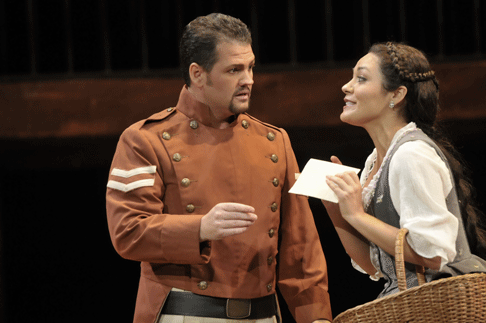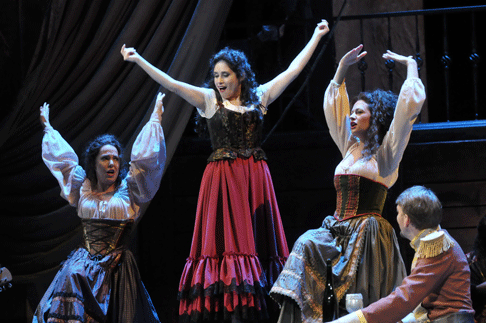07 Oct 2011
Carmen, Philadelphia
There are two ways to sing the role of Carmen: as a “grand opera” heroine and as a character from opéra-comique.

There are two ways to sing the role of Carmen: as a “grand opera” heroine and as a character from opéra-comique.
The grand opera version requires a voluptuous dramatic mezzo voice with a menacing flash of steel and booming chest tones. This musical style lends itself to a dramatic portrayal of the gypsy as a dangerous, snarling man-eater—a tigress capable of drawing a knife on Don José, had he not drawn one on her first. In the end, this Carmen seeks to seduce us by overwhelming us. This ideal is approximated by Grace Bumbry, Maria Ewing, Marilyn Horne, and, though she is always unique, Maria Callas.
The second type of Carmen, which reflects Georges Bizet’s roots in the French opéra-comique, calls for a smaller, more lyrical voice with a gentler timbre, smooth projection, and precise attention to delicate inflections of language and line. On this view, the gypsy is not a tigress but (as the libretto says of love) a bird. This Carmen is less blatantly threatening than her dramatic twin, yet her flirtatious, exotic, distantly self-absorbed manner poses just as great a danger to our hearts. She seduces not by overpowering but by mesmerizing. This approach is taken by Victoria de los Angeles and Teresa Berganza.
Most who sing Carmen these days aspire to the dramatic ideal, but Rinat Shaham, Philadelphia’s choice, fits the lyric model. Shaham is a Haifa-born mezzo who trained at the local Curtis Institute, debuted with the company as Zerlina in 1994, and has sung the role of Carmen to acclaim in theaters across the world, notably Glyndebourne. Shaham’s voice is not enormous, but it is focused, possesses an attractive sheen, and is articulated very evenly top to bottom. She phrases with understatement, a virtue lamentably absent among modern-day Carmen’s. Some quieter moments were memorable: the interposed “L’amour” in the “Toreador Aria” comes to mind, as does the Act III (“card”) trio, which suits her lovely low notes and contemplative manner. With black curls, flashing eyes, and slender curves popping out of the corset all Carmen’s seem to wear these days, she cuts an alluring figure on stage—and on posters throughout Philadelphia.
The result was in many respects agreeable. Absent throughout, however, were musical-dramatic subtleties essential for a lyric portrayal of Bizet’s gypsy to aspire to artistic greatness: the delicate use of glissando, rubato, rhythmic accent, idiomatic diction, timbre and color, and phrasing through the line. The “Habanera” was deadened by breathiness and an unyielding tempo, whether the fault of the conductor or singer. Shaham seemed to focus in the “Seguidilla” more on movement than voice, concluding with a needlessly strident cry. In the final scene, Shaham did not—vocally speaking—push herself to the edge of either desperation or fatalism. Without the extra interpretive effort, the performance seemed much blander than this artist’s potential, let alone the very best historical counterparts.
 David Pomeroy as Don Jose and Ailyn Perez as Micaela
David Pomeroy as Don Jose and Ailyn Perez as Micaela
Ailyn Pérez, the young Academy of Vocal Arts-trained soprano, posed a striking contrast as Michaëla. Pérez’s voice, pleasant and precise if slightly metallic, is no match for Shaham’s. Moreover, the plot turns in part on the obvious fact that neither the personality or music of Michaëla, the nice god-fearing girl from the country, can match that of Carmen. Yet Pérez imbued every line with creative imagination, especially the famous aria, where subtle dynamics, precise diction and firm sense of the where it was all going conjured up the evening’s most memorable moments and greatest applause.
Canadian tenor David Pomeroy made a solid Don José. Though his voice lacks the ring, precision or the sweetness some bring to the part, he phrased with intelligence and precision, improving as the night went on, and he looks the part of a proud, if unimaginative, Basque. Another young Curtis alum, Jonathan Beyer, cut an imposing figure as Escamillo, though his voice, though well-produced, is a bit less grand—a problem in a part where one wants to be overpowered by testosterone. Well-trained if uneven young voices, mostly the products of local institutions, appeared in the smaller roles.
The conducting by Philadelphia’s music director, Bergamo-born Corrado Rovaris, displayed what I have come to think are his characteristic strengths and weaknesses. He imbues performances with energy. The music moves along, and achieves a certain excitement in hard-driving, straight-forward passages—as in the famous Prélude. Yet the result can sound unimaginative where the score calls for flexibility, ambiguity, or shifts in mood.
 Rinat Shaham (center) as Carmen, Tammy Coil (left) as Mercedes and Greta Ball (right) as Frasquita, with Jeremy Milner as Zuniga
Rinat Shaham (center) as Carmen, Tammy Coil (left) as Mercedes and Greta Ball (right) as Frasquita, with Jeremy Milner as Zuniga
Visually, the production by Allen Charles Klein cleaves to a formula that has helped to make opera in Philadelphia popular and financially solvent: a grand unit set in traditional style, accessorized for each act with different props, costumes, and lighting—the latter sometimes tending toward slightly garish blues and oranges, courtesy of Drew Billiau. Outside of Act I, none of this adds much atmosphere or insight, but the audience seems to enjoy it. The stage direction, by David Gately, follows the formulas of previous productions, but enlivens them with a few fine touches: several suggestions of Carmen as a caged animal and liberty with the libretto, whereby she never finds the second-act castanets, dancing the duet instead with the (usually discarded) pieces of cracked plate.
Andrew Moravcsik